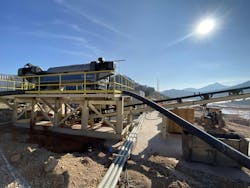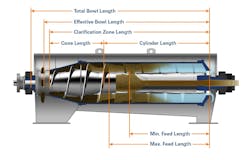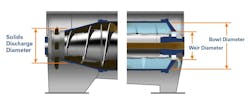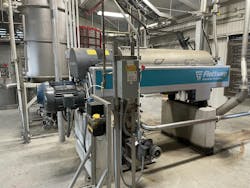Selecting the right centrifuge: Key factors to consider
Key Highlights
- Centrifuge selection depends on understanding physical parameters like G-force, suspension volume, retention time, and clarifying area, which directly impact separation efficiency.
- Operational control features such as variable frequency drives and adjustable weirs enhance adaptability, allowing for precise separation and process flexibility in changing conditions.
- Long-term considerations include choosing corrosion-resistant materials, wear-resistant components, and planning for maintenance and spare parts to ensure durability and cost-effectiveness over the centrifuge's lifespan.
- Balancing immediate performance requirements with long-term operational costs is essential for selecting a centrifuge that offers both efficiency and sustainability in industrial applications.
- Laboratory testing and pilot trials are recommended to validate centrifuge performance for specific materials, ensuring optimal selection tailored to unique process needs.
Centrifuges are essential in a variety of industries, from mining and hydrometallurgy to wastewater treatment and chemical manufacturing. These machines excel at separating liquids and solids, making them indispensable for processes requiring efficient solid-liquid or liquid-liquid separation. However, with so many models available, selecting the right centrifuge for a given application can be challenging. This article explores the critical factors that need to be considered when choosing a centrifuge, offering a straightforward guide to help engineers and decision-makers make informed choices.
1. Understanding the basics of centrifuges
Centrifuges work on the principle of centrifugal force, spinning mixtures at high speeds to separate substances based on density. Applications range from two-phase (liquid-solid) separations to three-phase (solid-liquid-liquid) separations. Industries use centrifuges to dewater sludges, clarify liquids, classify solids and recover valuable materials.
While the functionality of centrifuges may seem straightforward, selecting the most appropriate machine is far more complex than it appears. The decision should consider multiple variables that influence both the immediate performance and long-term efficiency of the machine. This involves not only understanding the physical characteristics of the centrifuge but also evaluating operational and control parameters and considering long-term aspects such as maintenance and wear resistance.
2. Physical parameters: The core of centrifuge selection
When comparing centrifuges, physical parameters play a significant role in determining their performance. These parameters, such as centrifugal force, suspension volume, retention time and clarifying area, directly affect the machine’s ability to handle different materials and achieve the desired separation. Let’s explore each parameter in detail.
Centrifugal force (G-force)
Centrifugal force is arguably the most significant factor in the separation process. The force generated is a function of the centrifuge’s rotational speed (RPM) and the radius of the bowl. In general, higher G-forces lead to better separation, particularly when dealing with fine solids or mixtures with similar liquid densities.
However, it is important to note that not all centrifuges operate at the same G-force. Larger centrifuges may have lower G-forces due to structural limitations, though this is not always true across manufacturers. When comparing centrifuges from different suppliers, ensure that both the design RPM and the operational RPM are considered, as some centrifuges may operate below their stated design speed, reducing their efficiency.
Suspension volume
Suspension volume refers to the total volume of liquid held within the centrifuge bowl. A larger suspension volume typically results in better separation, as it provides more time for particles to settle. The volume is affected by both the cylindrical and conical sections of the bowl. Larger suspension volumes are often preferred in applications requiring the separation of fine solids or when processing large quantities of material.
When evaluating suspension volume, it is essential to consider that different manufacturers calculate this parameter in various ways. For accurate comparisons, ensure that the same formula is applied across all centrifuges being evaluated.
Retention time
Retention time refers to how long the material remains inside the centrifuge under centrifugal force. Longer retention times generally lead to better separation efficiency. However, retention time calculations can be complicated by factors such as solid buildup in the machine or variations in feed composition. Each manufacturer may calculate retention time differently, making direct comparisons difficult.
A reasonable approximation for retention time can be derived from the suspension volume and feed rate, but it is important to adjust for the specific characteristics of the material being processed, such as particle size and phase densities. Pilot trials or laboratory tests are recommended when dealing with new or unfamiliar applications.
Clarifying area
The clarifying area is the wetted surface inside the bowl where separation occurs. In theory, a larger clarifying area improves the separation of solids from liquids. However, this value is often used as a marketing tool, with manufacturers using different formulas to calculate it. For example, a 73 cm diameter decanter may have a clarifying area that varies from 3.89 m² to 6.52 m² depending on the manufacturer’s calculations.
Since there is no standardized formula for clarifying area, it should be viewed as a rough indicator rather than a definitive measure of performance. The Sigma value (∑), or equivalent clarifying area, which attempts to equate the centrifuge’s performance to a static settling pond, can provide further insights, but again, different manufacturers use different methods to calculate this.
3. Operational and control parameters
Beyond physical attributes, operational and control parameters significantly impact a centrifuge’s overall performance and flexibility. Modern centrifuges offer advanced control systems that can adjust to fluctuating conditions, making them more adaptable to different processing environments.
Drive systems
A robust drive system is essential for handling variations in feed composition and rate. Variable frequency drives (VFDs) are particularly useful in these situations, allowing for real-time adjustments to the scroll and bowl speed. This ensures that the centrifuge can respond to changing conditions, producing a drier cake or clearer liquid as needed.
More sophisticated centrifuges can make these adjustments on the fly without stopping the machine. Fluctuations in solids loading can also be managed by torque control, which monitors and adjusts the scroll speed to prevent the centrifuge from becoming overloaded. This is particularly valuable in industries like mining or wastewater treatment, where feed composition can vary significantly. Modern systems allow scroll speed adjustments within 0.1 RPM, offering high precision that ensures stable performance across varying conditions.
Older systems, by contrast, rely on changing drive pulleys and belts — a time-consuming process that cannot handle on-the-fly adjustments. In high-precision operations where processing needs may shift rapidly, investing in centrifuges with advanced VFD control can prevent inefficiencies and machine downtime.
Weir control
Adjustable weirs allow for fine control over the retention time and separation process. Older centrifuge models use static weir plates, which must be manually adjusted and require the machine to be shut down. Modern designs, however, feature external adjustable weirs that can be controlled while the machine is running. In some cases, such as the Flottweg Tricanter, weir adjustments can even allow the machine to switch between two-phase and three-phase separation modes.
This level of control is particularly useful in applications with variable feed compositions, such as solvent extraction (SX) processes, where precise separation of organic and aqueous phases is required. The ability to adjust the weir without stopping the process can save time, improve separation quality and minimize material loss. Such systems are critical for industries with complex, multi-phase mixtures where even slight variations can affect output quality.
In cases where a fourth phase (such as ultra-fine particulates) builds up in a system like solvent extraction, having an adjustable weir ensures that these particulates can be properly separated without interrupting operations. This kind of flexibility makes modern weir systems an essential tool in advanced industrial processes.
4. Long-term considerations: Wear, maintenance and costs
The long-term performance of a centrifuge depends on more than just its immediate operational efficiency. Over time, wear and tear, the availability of spare parts and maintenance costs can have a significant impact on the total cost of ownership.
Materials of construction
The materials used in a centrifuge must offer corrosion resistance, abrasion resistance and structural strength. In corrosive environments, such as those with low pH and high chloride levels, selecting the right materials is crucial. For instance, while SAF 2205 may be suitable for some applications, SAF 2507 offers superior resistance to pitting and crevice corrosion, making it a better choice in more aggressive environments.
Choosing higher-grade materials may increase the initial cost of the centrifuge, but it can also extend the machine’s lifespan and reduce the risk of catastrophic failure.
Wear resistance and spare parts
Certain components, such as the scroll and discharge ports, are prone to wear and will need to be replaced periodically. Different manufacturers offer various wear-resistant materials, including tungsten carbide and ceramic inserts, which can extend the life of these parts.
When considering wear resistance, it is important to look beyond the lifespan of the materials. The ease of replacing worn parts and the availability of spares are equally critical. Some manufacturers may lower the initial cost of the centrifuge but compensate with expensive spare parts. Requesting a detailed quotation for running and strategic spares over the first two years can provide a clearer picture of the long-term costs.
Conclusion: A balanced approach to centrifuge selection
Selecting the right centrifuge involves balancing immediate performance needs with long-term operational considerations. By carefully evaluating the physical, operational and control parameters, as well as understanding the impact of materials and maintenance on long-term costs, decision-makers can make more informed choices.
While the centrifuge may not be the most expensive piece of equipment in a facility, it is often a critical one. A centrifuge can have a lifespan of 25 years or more, making it worth the effort to select the best option for your specific application. In the long run, investing time and resources in making the right choice will pay off in terms of both performance and cost-efficiency.
About the Author
Daniel Lakovic
Business Development Manager for Flottweg Separation Technology Inc.
Daniel Lakovic is the Business Development Manager for Flottweg Separation Technology Inc. Lakovic holds a BS in International Business and an MBA in Finance. He can be reached at [email protected].
Nils Schwarz
Director of Schwarz Global Consulting
Nils Schwarz is Director of Schwarz Global Consulting. Schwarz Global Consulting was founded in 1998 to provide consulting services to the hydrometallurgical industry. These services include process development and optimization as well as the design of small, fine chemicals manufacturing facilities.



